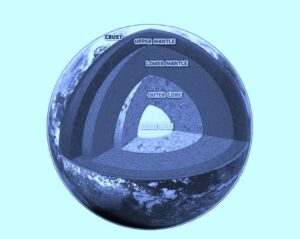
Physical and World Geography MCQs – 01 (Latitudes and Longitudes)
Most important MCQs from the chapter – Latitudes and Longitudes MCQs.
Home » UPSC Study Materials » Prelims Express » Chapterwise MCQs » Physical and World Geography MCQs » Physical and World Geography MCQs – 02 (Interior of the Earth)
Interior of Earth MCQs with answers and explanations for all examinations.
1. Consider the following statements:
1. The uppermost layer over the earth surface is called the “crust” and it is the thinnest of all the layers.
2. The thickness of the ocean crust is more than the continental crust.
Which of the above statements is/are true?
(a) 1 only
(b) 2 only
(c) Both 1 and 2
(d) Neither 1 nor 2
Correct Answer – (a) 1 only
 The interior of the earth can be divided into 3 different layers:
The interior of the earth can be divided into 3 different layers:2. Consider the following statements:
1. The Mantle has a density higher than the Crust.
2. The asthenosphere is the lower portion of Mantle.
Which of the above statements is/are true?
(a) 1 only
(b) 2 only
(c) Both 1 and 2
(d) Neither 1 nor 2
Correct Answer – (a) 1 only
3. Consider the following statements:
1. The core is made up of very light materials like Silica (Si) and Aluminium (Al).
2. The inner core is in the solid-state whereas the outer core is in the liquid state.
Which of the above statements is/are true?
(a) 1 only
(b) 2 only
(c) Both 1 and 2
(d) Neither 1 nor 2
Correct Answer – (b) 2 only
4. Consider the following statements:
1. Transition zone between Mantle and Core is known as Gutenberg Discontinuity.
2. Transition zone between the Crust and Mantle is known as Mohorovicic Discontinuity.
Which of the above statements is/are true?
(a) 1 only
(b) 2 only
(c) Both 1 and 2
(d) Neither 1 nor 2
Correct Answer – (c) Both 1 and 2
5. Consider the following statements:
1. Continental crust is mainly made from a rock called granite.
2. Oceanic crust is mainly made from a rock called basalt.
Which of the above statements is/are true?
(a) 1 only
(b) 2 only
(c) Both 1 and 2
(d) Neither 1 nor 2
Correct Answer – (c) Both 1 and 2
6. Consider the following statements:
1. The transition zone between the upper core and the lower core is called Lehmann Discontinuity.
2. The transition zone between the upper mantle and the lower mantle is known as Repetti Discontinuity.
Which of the above statements is/are true?
(a) 1 only
(b) 2 only
(c) Both 1 and 2
(d) Neither 1 nor 2
Correct Answer – (c) Both 1 and 2
7. Which among the following is not a source of Information about the interior of the earth ?
(a) Volcanic eruptions
(b) Meteors
(c) Seismic Waves
(d) Rivers
Correct Answer – (d) Rivers
8. Consider the following statements:
1. Pressure increases from the surface towards the center of the earth.
2. Temperature decreases from the surface towards the center of the earth.
Which of the above statements is/are true?
(a) 1 only
(b) 2 only
(c) Both 1 and 2
(d) Neither 1 nor 2
Correct Answer – (a) 1 only
9. Consider the following statements:
1. Rocks formed when molten lava comes on the earth’s surface, cools down and becomes solid are called extrusive Igneous rocks.
2. Rocks formed when molten lava cools down deep inside the earth’s crust and becomes solid are called intrusive Igneous rocks.
Which of the above statements is/are true?
(a) 1 only
(b) 2 only
(c) Both 1 and 2
(d) Neither 1 nor 2
Correct Answer – (c) Both 1 and 2
10. Consider the following statements:
1. Extrusive igneous rocks are made up of large grains.
2. Intrusive igneous rocks have a very fine grained structure.
Which of the above statements is/are true?
(a) 1 only
(b) 2 only
(c) Both 1 and 2
(d) Neither 1 nor 2
Correct Answer – (c) Both 1 and 2
11. Consider the following statements about sedimentary rocks ?
1. These are formed by the deposition of various types of sediments in layers.
2. There is no possibility of finding fossils in these rocks.
Select the correct statements from the codes below:
(a) 1 only
(b) 2 only
(c) Both 1 and 2
(d) Neither 1 nor 2
Correct Answer – (a) 1 only
12. Consider the following statements about Igneous Rocks ?
1. Igneous rocks are primary rocks.
2. Igneous rocks can be changed into sedimentary rocks but not into metamorphic rocks.
(a) 1 only
(b) 2 only
(c) Both 1 and 2
(d) Neither 1 nor 2
Correct Answer – (a) 1 only

Most important MCQs from the chapter – Latitudes and Longitudes MCQs.

Most important MCQs from the chapter – Types of winds MCQs.

Most important MCQs from the chapter – Atmosphere MCQs.

Most important MCQs from the chapter – The Universe and Solar System MCQs.

Most important MCQs from the chapter – Oceans MCQs.

Most important MCQs from the chapter – Ocean Currents MCQs.

Most important MCQs from the chapter – Plate Tectonics and Earthquakes MCQs.
We are adding new Notes, Chapterwise MCQs, Quizzes, Previous Years Questions everyday
We are adding new Notes, Chapterwise MCQs, Quizzes, Previous Years Questions everyday